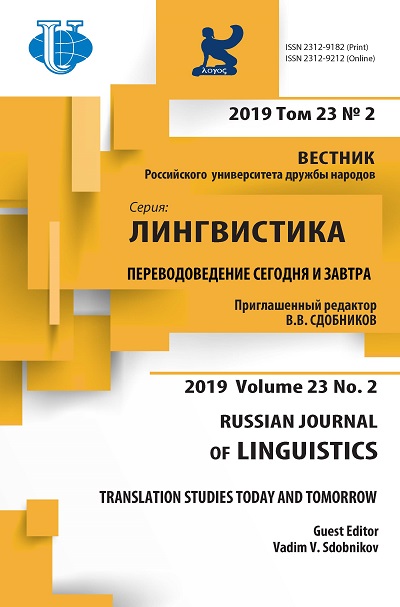Том 23, № 2 (2019): Переводоведение сегодня и завтра
- Год: 2019
- Статей: 20
- URL: https://journals.rudn.ru/linguistics/issue/view/1192
- DOI: https://doi.org/10.22363/2312-9182-2019-23-2
Весь выпуск
ПЕРЕВОДОВЕДЕНИЕ СЕГОДНЯ И ЗАВТРА
Переводоведение сегодня: вечные проблемы и новые вызовы
Аннотация
 295-327
295-327


Путь к тексту: лингвистические и функциональные особенности заглавий книг и способы их перевода
Аннотация
 328-343
328-343


Влияние инновационных технологий на перевод и переводоведение
Аннотация
 344-361
344-361


Интертекстуальность как переводческая проблема: эксплицитность и узнаваемость при переводе из «литератур небольших народов»
Аннотация
 362-382
362-382


Перевод идеологии в ракурсе межгруппового посредничества
Аннотация
 383-398
383-398


«Чувственный образ бесконечности»: интерсемиотический перевод русской классики для зарубежной аудитории
Аннотация
 399-414
399-414


Волшебные сказки в свете интерсемиотического перевода
Аннотация
 415-434
415-434


Лингвокультурная локализация кинозаголовков
Аннотация
 435-459
435-459


Деформация языка в произведениях Дж. Джойса: проблема интерпретации и перевода
Аннотация
 460-472
460-472


Особенности перевода художественного текста с русского языка на испанский (на материале перевода романа Евгения Водолазкина «Авиатор»)
Аннотация
 473-486
473-486


Интерпретация реалий при переводе сакрального текста: языковой и экстралингвистический аспекты
Аннотация
 487-508
487-508


Модальность высказывания в переводе Корана на русский язык
Аннотация
Риторический вопрос имеет такую же форму, что и обычный вопрос, но выполняет иную функцию: вместо запроса информации он может выражать опровержение, утверждение, оценку, приравнивание или отрицание. В настоящей работе рассматриваются способы передачи риторических вопросов в двух переводах Корана на английский язык. Другими словами, это сопоставительное исследование, цель которого - определить, приводят ли грамматические изменения риторических вопросов в двух английских переводах Корана к изменению модальности опровержения, утверждения, оценки, приравнивания и отрицания. Исследование опирается на теорию регистров М.А.К. Хэллидея и Р. Хасан (1985) и теорию переводческих сдвигов Дж. Кэтфорда (1965). В качестве материала исследования используются выдержки из Корана, а также два английских перевода Корана: “The Koran Interpreted by Arberry” (1955) и “The Noble Quran: English translation of the meanings and commentary by al-Hilali and Khan” (1996). Проведенный анализ свидетельствует о том, что грамматические изменения риторических вопросов в двух переводах приводят к изменению их модальности и, соответственно, их функции. Эти грамматические изменения различного уровня и типа представляют серьезную проблему с точки зрения сохранения модальности при переводе. Показано, что теория регистров Хэллидея и Хасан (1985) является удобным инструментом в процессе перевода.
 509-522
509-522


Гендерно-нейтральные лингвистические трансформации мессианских священных текстов в современной англиканской гомилетической литературе
Аннотация
 523-543
523-543


Использование компьютерных переводческих инструментов: новые возможности, новые ошибки
Аннотация
 544-561
544-561


РЕЦЕНЗИИ НА КНИГИ
Новые тенденции в современном переводоведении Рецензия на монографию: Мишкуров Э.Н. «Герменевтика перевода» (теоретико-методологический стандарт) Москва: Военный университет, 2018. 299 с
Аннотация
 562-568
562-568


Рецензия на учебное пособие: Шлепнев Д.Н. Общая теория перевода: начала. Введение в ремесло 2-е изд., перераб. и доп. Н. Новгород: НГЛУ, 2019. 354 с
 569-574
569-574


ИНТЕРВЬЮ С ПЕРЕВОДЧИКАМИ
INTERVIEWS WITH TRANSLATORS AND INTERPRETERS
 575-580
575-580


ИНТЕРВЬЮ С ПЕРЕВОДЧИКАМИ
 581-583
581-583


INTERVIEWS WITH TRANSLATORS AND INTERPRETERS
 584-590
584-590


ИНТЕРВЬЮ С ПЕРЕВОДЧИКАМИ
 591-594
591-594
















